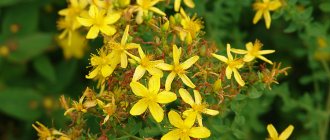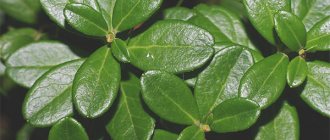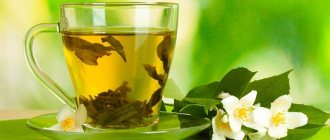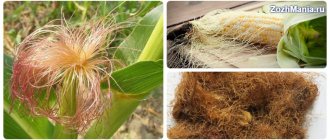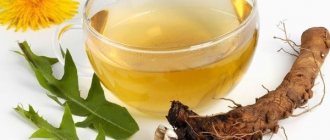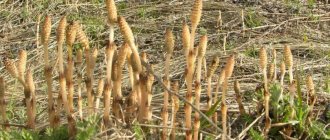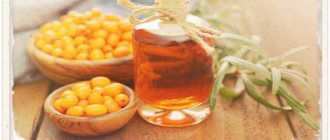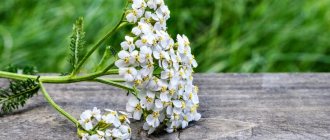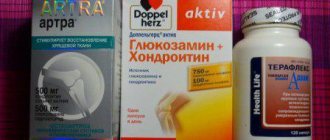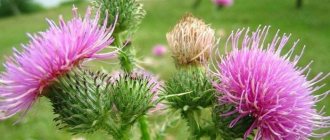Peppermint has been known for a long time, it was used a thousand years BC. Mentions of this herb are found in the works of Pliny and Avicena, where the plant is mentioned as calming and improving thinking. Currently, the medicinal properties of peppermint have been fully studied and confirmed by scientists.
There is even an ancient Greek myth about peppermint according to which a Nymph named Menta was the beloved of Hades. Persephone's wife became jealous and turned her into grass, and Hades, in memory of his love, made her unusually fragrant.
Peppermint has found its own use in every country. For example, the famous French omelet always includes mint, the Germans sprinkle pea soup with sprigs of peppermint, the Austrians love potato dumplings, homemade cheese with herbs. Mint tea is popular not only in Russia; Moroccans and Tunisians consider it part of a daily ritual. In Europe they drink mint punch, we have mint kvass.
Botanical description
Peppermint is a herbaceous perennial belonging to the Yamnotaceae family. This is a variety of common mint, bred through selective breeding. Therefore, it does not grow in nature, but is grown by summer residents on their plots.
Peppermint can be distinguished from other types of mint by its strong specific aroma and cooling taste, which is caused by the presence of menthol in the composition.
The plant has a fibrous structure with a rhizome lying horizontally. Erect faceted stems of rich purple color, with slight pubescence, 40-90 cm high.
The leaves are attached oppositely. The plates are large-scale - approximately 9x3 cm. The outside is dark green and glossy, the inside is a little paler and rough. In configuration they are closer to an oval, but jagged along the edges and with a sharp tip.
Mint blooms from June to September with small inflorescences collected in spike-shaped brushes of light lilac color.
Then it begins to bear fruit, forming compact brownish fruit capsules, like nuts. The plant rarely produces seeds, so it is bred mainly by layering or roots.
Existing varieties of peppermint:
- black - cuttings and foliage have a dark purple tint;
- white - without any tint, purely green.
Black mint has a richer and sharper aroma than white mint, and it blooms later.
Medicinal properties of mint. Video:
Recipes with mint
If there are no contraindications, the beneficial properties of the plant can be used for the benefit of health through internal or external use.
In the recipes described, mint can be dried or fresh. If you don’t have your own preparations, the herb can be purchased at any pharmacy chain.
Mint leaves in their pure form or as part of complex supplements are often used for meat dishes (especially lamb), which most men love.
Mint tea
This drink is good hot or cold.
- In the first case, you need to add fresh or dried mint leaves to pure green or black tea and brew the herb for 7-10 minutes.
- For a rich taste and greater benefits, you can add a spoonful of honey and a slice of lemon to the drink - mint goes especially well with these products and clearly reveals its taste.
- On hot days, you can add fresh mint to your brewed tea, wait 20 minutes for it to absorb the refreshing taste and cool, then add a few pieces of ice. This drink can be stored in the refrigerator for no more than a day.
Compound
Peppermint contains many significant components, which explains its benefits for the human body. Biochemical composition includes:
- essential oils, mainly menthol;
- tannins;
- ascorbic acid;
- minerals;
- carotene;
- vitamins P and B;
- pectins;
- phytoncides;
- betaine;
- phytosterols;
- microelements;
- Sahara;
- starch;
- cellulose.
The nutritional value of 100 g of grass is about 70 kcal.
Medicinal properties
The main active ingredient in preparations based on mint is menthol, which is part of its essential oil. Contacting the surface of the skin or mucous membranes, menthol irritates cold receptors, promotes the narrowing of superficial blood vessels and the reflex expansion of blood vessels supplying blood to internal organs.
Due to its mild local anesthetic effect, peppermint is included in medications (for example, validol) intended to relieve angina attacks.
The effects of peppermint can be:
- vasodilator;
- antiseptic;
- calming;
- painkillers;
- anti-inflammatory;
- diuretic;
- sedative;
- antispasmodic;
- choleretic;
- anticancer;
- expectorant;
- carminative;
- antiemetic;
- sweatshop.
Mint: beneficial properties and contraindications
Mint is endowed with many beneficial properties that are successfully used for preventive and medicinal purposes. The persistent spicy aroma and taste of the herb is provided by the essential oils in the composition, which determine a significant part of its healing effects.
Medicinal properties of peppermint:
- anti-inflammatory;
- antiseptic;
- immunomodulatory;
- regenerating;
- decongestant;
- choleretic;
- fat burning;
- antibacterial;
- sedative;
- tonic;
- pain reliever;
- antispasmodic.
Thanks to phytosterols, there is a beneficial effect on the cardiovascular system: “bad” cholesterol is eliminated, capillary permeability decreases and their elasticity increases. This prevents heart attacks, strokes, and atherosclerosis.
The use of decoctions and infusions helps with many health problems. Here is a short list of the benefits of mint:
- normalizes digestion by activating liver fat metabolism and stimulating bile formation;
- increases the body's resistance to viruses and bacteria, which is especially important during the cold season;
- calms, relieves irritability, relieves insomnia and improves the psycho-emotional state in general;
- suppresses headaches in case of frequent migraines;
- relieves spasms of smooth muscles, which allows you to relax and reduce pain due to intestinal upset;
- smoothes out painful symptoms of PMS;
- accelerates the healing of purulent wounds and ulcers;
- relieves inflammatory processes of any origin and disinfects, which helps with a number of diseases: colds, sore throat, stomatitis, gingivitis, caries, bronchitis;
- suppresses attacks of nausea.
Mint infusions and decoctions treat pathological dysfunctions of the liver and gall bladder.
During pregnancy and breastfeeding
The benefits of this aromatic herb are multifaceted, but it is worth especially considering the case when a woman is carrying a child. Mint during pregnancy is not contraindicated in the first trimester, but in limited quantities. It is recommended to add several leaves to tea (2-3 pieces per cup).
The benefits of this drink:
- calms;
- has anti-inflammatory and analgesic effects;
- relieves attacks of nausea, prevents dizziness;
- relieves heartburn;
- tones blood vessels, which serves as a prevention of varicose veins;
- improves the functioning of the digestive system.
Peppermint infusion and oil should not be taken by pregnant women, as tanning agents and organic acids in the composition can harm the formation of the fetus.
In the second trimester, regular mint will be an alternative, but also in measured quantities.
In the later stages, any mint is completely abandoned, which can cause premature birth, which is due to the presence of the female hormone estrogen in it. In addition, the grass overloads the kidneys and negatively affects cardiac activity.
A cup of mint tea will not cause any harm to women who are breastfeeding. On the contrary, it will help dilate blood vessels and increase blood circulation.
If lactation is insufficient, then it is better to avoid mint, as it will reduce it even more.
In any case, you should first consult a doctor.
Contraindications and possible harm
Despite the extensive list of beneficial properties, mint has a number of contraindications. These include:
- individual intolerance to individual components in the composition - it is recommended to do an allergy test first;
- low blood pressure (hypotension) - the herb will lower it even more;
- varicose veins – weakens the tone of the vascular walls;
- 2-3rd trimester of pregnancy, which can stimulate miscarriage;
- heartburn;
- children under 3 years old.
Long-term uncontrolled use of medicinal forms of peppermint can cause drowsiness and depression.
Preparation of peppermint. Video:
What are the benefits of using mint
Thanks to its active ingredients, mint has various beneficial properties and can help combat many disorders.
Let's look at the benefits of using this plant:
- Relaxes the gastrointestinal tract. Thanks to the action of menthol, mint has a pronounced activity that relaxes smooth muscles, in particular, the stomach and intestines. For this reason, it is useful for combating spasms and pain in the stomach and intestines, as well as against nausea, discomfort caused by poor digestion, and acts as a laxative.
- Relieves inflammation of the respiratory system. Peppermint essential oil has an anti-inflammatory and analgesic effect on the upper respiratory tract; Fumigations with this oil are very useful against bronchial inflammation and sinusitis.
- Invigorates the nervous system. Mint has a stimulating effect on the central nervous system, for this reason it is often used against exhaustion and fatigue, both physical and psychological.
- Gives relief to irritated skin. Peppermint can also be used in oil form to provide immediate relief in cases of irritated and dry skin.
- May alleviate hirsutism. According to a recent study conducted in Turkey, when excess hair in women is associated with polycystic ovary syndrome, mint may help regulate the production of androgen hormones that cause this problem.
Peppermint oil: properties and uses
Peppermint oil has a similar list of beneficial properties. The raw materials for its production are collected exclusively during full flowering, when the plant accumulates valuable components to the maximum. The finished product contains:
- carvone;
- limonene;
- menthol;
- acetic and valeric acid;
- dipentene;
- citral.
Premium class oil is distilled from the leaves and inflorescences, and lower class oil from the stems. It is obtained in two ways - water or steam distillation, followed by purification (rectification).
As a result, harmful volatile sulfur inclusions are eliminated from the composition. The rich aroma is obtained by infusing the oil for a certain period of time.
Peppermint oil dissolves in alcohol and in a concentrated state has a light olive color.
The taste is scalding and refreshing. It must be stored in a dark place, otherwise, under the influence of light, the oily liquid thickens and darkens.
Areas of application of mint essential oil:
- Insomnia. To normalize sleep, place 3-4 drops on a cotton pad and place it next to the pillow.
- Migraine. Rub a small amount of oil into the temple area.
- Colds. A little ether is applied to the chest, back, neck and feet. The fever will subside fairly quickly, and your health will improve significantly.
- Dental problems. Lubricate painful and inflamed areas in the oral cavity with oil concentrate.
Essential oil is no less in demand in cosmetology. It helps:
- remove vascular plaques;
- eliminate acne;
- even out facial tone, smooth out fine wrinkles;
- prevent hair loss.
Regular cosmetic procedures based on mint herb restore a healthy appearance to the face and increase the protective functions of the skin.
Just a few drops in a salt bath will help relieve fatigue and heaviness in the legs.
Why men can't have mint
The main concerns relate to herbal drinks. Can men drink mint tea?
There is an opinion that it has a bad effect on potency. Thus, US scientists, in the course of an experiment, through the reaction of a laboratory mouse to regular consumption of mint tea, found that this is true .
The drink caused a decrease in testosterone, which is the main male hormone. As a result, libido decreased, and in some specimens the experiment even led to testicular dysfunction and infertility.
It is also believed that sedative effects can reduce the strength of sexual desire and arousal. On the other hand, sexual desire is unlikely to arise in an irritated, tired, depressed or depressed state, which mint helps to cope with perfectly.
For mint to have unpleasant consequences, it must be drunk daily and in large quantities. Rare consumption of mint tea, refreshing drinks with little mint content, chewing gum or toothpaste do not pose a danger to men's health.
Even in menthol cigarettes, the threat to the body lies not in the plant component, but in the very fact of smoking and nicotine addiction, which is truly dangerous for the reproductive system.
On a note:
Since mint has a relaxing and calming effect, its use may affect concentration levels, so it is not recommended to drive or engage in activities that require special alertness.
Application
Various medicinal compositions are made at home based on peppermint: water infusions, decoctions, tinctures, tea. In cooking, crushed herbs are added to various dishes and drinks.
Infusion and decoction
Decoctions and infusions are made using similar technology, only in the latter case it requires an exposure of 1-2 hours. Both freshly harvested and dried herbal raw materials are used as a basis.
Cooking recipes and instructions for use:
1. Infusion: steam 30 g of herb with 200 ml of boiling water, infuse and filter. Drink warm, adding honey or sugar if desired.
Indicated for cardiovascular and digestive pathologies, migraines, insomnia, nausea, poor bile discharge. They also rinse the mouth to relieve inflammation and pain during sore throat and flu.
2. Decoction: 500 ml of water will require 1 tbsp. l. medicinal raw materials, which are boiled for a quarter of an hour over low heat. After standing for twenty minutes, take 12-15 ml before meals for a month.
Helps relieve premenstrual syndrome during painful periods and improve well-being during menopause. Also indicated for lowering blood pressure.
It is useful to drink mint water in the summer, which effectively refreshes and tones.
It’s easy to prepare: throw a few fresh mint leaves into half a liter of water and put it in a cool place.
5-6 hours is enough and you can drink it.
Alcohol tincture
Dry or fresh foliage is used for tincture. As a result of simple manipulations, an effective therapeutic and preventive remedy is obtained that can significantly improve health.
Peppermint tincture is prepared as follows:
- Pour 1 tbsp into a glass container. spoon of dried mint, pour 100-120 ml of high-quality vodka. Place in a dark and cool place for 2-3 weeks. After the allotted time has passed, filter and take 15-18 drops daily (pre-dissolved in water) shortly before meals.
- Fresh grass and inflorescences, in the amount of 5-6 branches, are placed in an appropriate container and brewed with boiling water (200 ml). Leave for at least 2 hours. Then add granulated sugar - 110 g and vodka - 0.5 l. Stir, seal and place away from light for 2 weeks.
The resulting tincture is used to rinse the mouth (1-2 potassium is dissolved in water). A course of 10-12 days helps with a number of diseases:
- sleep disorder;
- nervous breakdowns;
- poor appetite;
- heart failure;
- digestive disorders;
- female genital pathologies;
- insomnia, frequent headaches.
With the tincture you can make warm compresses on the chest and back for colds.
Treatment with alcohol tincture is contraindicated for: hypotensive patients, pregnant women and during lactation, children under 13 years of age.
Mint tea: benefits and harms
Tea with fragrant mint not only brings a lot of pleasant sensations when consumed, quenches thirst and refreshes on a hot day, but also adds health. This is the best way to calm down and relax after the daily hustle and bustle.
A cup of mint tea with a spoon of honey before bed will quickly restore your emotional background and help you fall asleep.
In addition, this drink is recommended to be included in the daily diet for people suffering from lack of appetite, constipation, and swelling in the morning. For colds, it will speed up the recovery process and strengthen the immune system.
Cooking recipes:
- Pour 25-35 g of dried pepper herb into a porcelain teapot, pour boiling water (about a glass) and let it brew for 10 minutes.
- Fresh green leaves are finely chopped and added to regular tea leaves. 4-5 sheets are enough.
For children, make a drink of low concentration: 1 tbsp. l. raw materials per 500 ml of water. After ten minutes of exposure, filter and add natural honey (to taste).
Important! You can drink tea every day for a week, then replace it with some other type or take a break for two weeks.
Non-medical uses of the plant
Due to its pleasant taste and attractive aroma, the herb is widely used for preparing various dishes and drinks .
Mint is added to alcoholic and refreshing cocktails, which quench thirst well in the summer heat; it is also added to salads, hot fish and meat dishes, pastas, baked goods and sweets.
Mint is a common component of cosmetic products : tonics, masks that refresh the skin, relieve swelling, improve blood circulation, tighten pores and help fight rashes. Also used for relaxing evening baths.
The plant is added to toothpastes and rinses not only because of its refreshing effect, but also due to its bactericidal properties, which prevent the development of bacteria and inflammatory processes in the gums.
Preparation and storage
The peppermint harvest period begins with the beginning of flowering, usually lasting July and August. The most essential oils in a plant are contained when a significant part of the flowers have not yet bloomed, but have just entered the budding stage, and foliage continues to grow. Upon completion of this stage, the concentration of essential oils in the plant decreases.
The above-ground part of the plant is harvested by mowing it and then drying it in the fresh air or in dryers. Ready-to-use medicinal raw materials are green in color; glistening glands containing essential oil may be visible in the lower part of the leaves. When properly stored, the healing properties of raw materials are preserved for two years.
How and when do you use mint?
Mint is used not only as a medicinal plant in the form of decoctions, infusions, teas or medications. In some national cuisines, mint is included in sauces, seasonings for meat dishes, and additives for desserts. In this case, leaves, stems, and inflorescences are used. Can be used both dried and fresh. Mint is an indispensable component when baking baked goods and making soft drinks.
Widely known mints with menthol are recommended to be consumed at the first sign of nausea (on airplanes, for pregnant women).
Pharmaceutical mint products
Mint tablets. Improves the general condition of the body. Take 1 tablet “under the tongue”. These tablets are soothing and tonic. For spasms of smooth muscles, urge to vomit, and signs of nausea, such tablets are irreplaceable.
Pectusin tablets. Prescribed for the treatment of diseases of the nose, bronchi, larynx, trachea.
Boromenthol ointment . Prescribed to destroy microbes in the wound and relieve pain. Used for itchy skin and neuralgia. When you have a runny nose, lubricate the inner surface of the turbinates.
Ointment "Efkamon" . Used for inflammation in muscles, inflammation of joints, and diseases of peripheral nerves. Apply to the sore spot and rub in. Do not use if the skin is damaged.
Ointment "Menovazin" . Acts as an analgesic for neuralgia, pain in muscles and joints, and skin itching.
Mint drops. Used internally to eliminate nausea and stop the urge to vomit.
Drops "Eucatol" . Designed for rinsing in case of nasopharyngeal disease.
Zelenin drops. Used to calm the nervous system in heart diseases.
“Mint” water (peppermint hydrolate). Rinse the mouth in case of dental abnormalities.
Validol drops . Vasodilator, sedative drug for signs of angina pectoris, neuroses.
Aerosol "Camphomen" . Used for runny nose, chronic rhinitis, inflammation of the throat and bronchi. It is not recommended to use more than 4 times a day.
Olimethine capsules. Applicable in the treatment of diseases associated with kidney stones and difficulty in removing bile from the gallbladder.
Folk remedies
In alternative medicine, mint is used for teas, decoctions, water and alcohol tinctures. Juice and mint pulp are also made at home from young shoots and mint leaves. The juice is used both internally and externally. The gruel is for external use only.
To make juice, you need to pour 300 g of washed leaves and shoots of the plant through a meat grinder and pour 1 liter of “steep” boiling water. Wrap the container in warm material and let it sit for 3 hours. Strain, sterilize in glass jars for 25 minutes, close hermetically (“roll up”). The juice is ready. Use it in the same way as a decoction or infusion, reducing the concentration. Store canned juice in a cool, dark place.
Gruel is mint leaves crushed through a meat grinder. Used to relieve headaches. The paste is applied to the frontal, occipital or temporal parts. They wrap it up. Leave for 40 minutes.
Peppermint pulp helps with fungal foot infections. It is applied between the fingers and left for 1 hour.
Peppermint essential oil
One of the most powerful natural medicines with a high menthol content is peppermint essential oil. It has a beneficial effect on a person and his nervous system. This natural component calms the psyche and is indispensable for relieving nervous tension or stress.
Oil can not only cure illness, overcome infections and pain, but also restore human strength and the functioning of all vital organs.
Throughout the history of the use of this oil, humanity has learned to use it with maximum efficiency. The oil is used in the manufacture of pharmaceuticals; traditional healers use it for various diseases in the form of decoctions, alcoholic and water infusions, and teas.
Peppermint essential oil is an essential natural component of perfumes and cosmetics.
Cooks and confectioners widely use oil in the production of food, desserts, tonic drinks and various confectionery products.
Mint tea and its properties
A mint drink has many advantages over regular black tea. It acts as a sedative for the nervous system and relieves excessive stress. For those who want to lose weight, mint tea is simply irreplaceable - a large amount of essential oils in mint dulls the feeling of hunger.
Brewed mint tea contains substances that have a strengthening, tonic and healing effect on the human cardiovascular system, regulates the functioning of the gastrointestinal tract, promotes the removal of bile, and stabilizes the functioning of the kidneys and liver.
The use of mint in combination with other medicinal herbs dulls inflammatory processes in the body.
Application in cosmetology
Mint is an indispensable natural product in cosmetology. It is used to make rejuvenating face masks, tonic body baths, cleansing skin lotions, and pain-relieving compresses.
Simply rubbing the prepared mint infusion (pour 25 g of mint leaves with a tablespoon of boiling water) relieves skin inflammation. Ice cubes from the frozen infusion restore and refresh the skin at the site of application.
To relieve fatigue and improve facial skin tone, apply mint infusion compresses to the front side of the head. A 10-minute procedure is enough to restore an attractive appearance.
Peppermint essential oil plays an important role in cosmetology. It is actively used in removing acne, to improve complexion, and to restore the balance of skin moisture.
Essential oil is not used in its pure form. You need to dilute a few drops of this oil with 20 g of flaxseed or olive oil.
For varicose veins, allergy sufferers, or individual intolerance to the aroma of menthol, it is better to refrain from using such procedures.
A rejuvenating face mask that has worked well for women: mix 25 g of the above mint infusion with 50 g of fresh warm milk and 100 g of oatmeal crushed in a meat grinder. Apply the prepared paste mixture to your face, leave for 20 minutes and rinse. It is recommended to remove makeup from the face before applying. This procedure is best performed in a calm state, before bedtime.
Many women are concerned about the presence of dandruff on the head, dullness and brittle hair, and increased oiliness of the scalp. Peppermint will help eliminate such flaws. To enhance hair growth and blood circulation in the scalp, relieve irritation, itching and inflammation of the scalp, 2 drops of essential oil added to 10 g of shampoo will help.
Hair rinse prepared at home is widely used. Add 4 drops of oil to the above mint infusion. After washing your hair, thoroughly rub the prepared solution into the hair roots and rinse.
For oily hair, prepare a composition using egg yolk. For 2 yolks add 15 g of lemon juice and 4 drops of mint essential oil. Place the mask on your head and cover with film. After 20 minutes, wash with shampoo and rinse with plenty of water.
For colored hair, use a mixture of castor and essential oils (add 2 drops of mint to 25 g of castor oil). This mask is kept under film for 50 minutes. Wash off with simple shampoo.
Mint for angina
With age, every person experiences a narrowing of the blood vessels located in the heart area. A feeling of squeezing pain in the chest, rapid heartbeat - this is angina pectoris. Peppermint has a good vasodilator and analgesic effect. To prevent and reduce the number of angina attacks, it is recommended to use various decoctions, tinctures, and teas containing mint.
Decoction. 50 g of dry crushed mint stems and leaves should be boiled for 5 minutes over low heat in 250 ml of water. After 30 minutes, strain. Take 100 ml before meals.
Tea. You need to brew 100 g of dry crushed mint flowers, leaves and stems in 1 liter of “steep” boiling water. Take as regular tea.
Infusions:
- 25 g of mint leaves, pre-crushed, must be mixed with 10 g of finely ground valerian root and poured with a glass of “steep” boiling water. Infuse in an airtight container in a dark place for 2 hours. The infusion should be taken for 3 weeks, 1 teaspoon before meals in the morning and evening. After the course, take a break for 15 days. Then repeat.
- 30 g of crushed dried flowers, mint leaves and lily of the valley need to be poured with “steep” boiling water. Stand for 1.5 hours. Take 1 teaspoon before meals 2 times a day for 7 days. Take a break for 20 days. Repeat the course.
- 50 g of dry stems, flowers and leaves of mint mixed with 50 g of dill seeds, pour 0.5 liters of boiling water. Leave for 3 hours. Take 1 tablespoon morning and evening. The course of treatment lasts 15 days. After a break of 20 days, the course must be repeated.
- For preparation you will need peppermint flowers, leaves and stems; birch leaves; wild blackberry leaves; rowan fruits; hawthorn fruits; dog-rose fruit; valerian rhizomes; nettle; sweet clover Pour 50 g of dry, powdered collection (in equal parts) into 1 liter of “steep” boiling water and leave for 20 minutes in a water bath. Leave for 3 hours. After straining, take 0.5 cups during an attack.
All recipes given are for informational purposes only. Before use, you should consult your doctor.
Mint for gastrointestinal diseases
Mint has found wide use in herbal medicine in the treatment of various gastrointestinal diseases. For this purpose, decoctions, infusions, and teas are used.
Decoction. Pour 25 g of dry leaves, stems and flowers of peppermint into 250 g of cold water, bring to a boil and simmer over low heat for 15 minutes. Strain and take 200 g 2 times a day for 15 days for inflammation of the esophageal mucosa . To this decoction you can add either 25 g of dry viburnum leaves or 50 g of dry blackcurrant leaves.
Infusions. You need 100 g of a mixture consisting of
- dried peppermint flowers and leaves;
- flax seeds;
- fennel fruit;
- dried linden flowers;
- rhizomes of calamus;
- licorice roots
Take 25 g of all ingredients, grind into powder and pour in 750 g of “steep” boiling water. Then let it brew for 4 hours and take 150 g at high acidity
For stomach ulcers, it is recommended to take 50 g of chamomile inflorescence, 50 g of dry mint leaves and pour 500 g of “steep” boiling water. Infuse for 1 hour. Then you need to take 1 tablespoon before meals 3 times a day.
Teas. Brew 30 g of a dry mixture consisting of juniper fruits, cumin, fennel, chamomile inflorescences and peppermint (in equal parts by weight) like ordinary tea. Take 200 g after lunch and before bed for indigestion and flatulence .
Mint tea, brewed according to a simple recipe for ordinary tea, tastes the most pleasant and is ideal for the prevention of gastrointestinal diseases at an early stage.
In which drugs is it found?
Peppermint is a component of more than a dozen medicines, the most famous of which are:
- "Validol", produced in the form of drops, tablets or capsules. The menthol solution, which is the active component of the drug, irritates the receptors of the mucous membranes of the oral cavity, provoking a reflex expansion of spasmodic coronary vessels.
- "Corvalol" - drops intended for internal use and have a sedative and vasodilator effect in cardiovascular pathologies (tachycardia, increased blood pressure, cardialgia), neurotic conditions and insomnia.
- "Valocordin" is a combined medication that has a sedative, antispasmodic and hypnotic effect.
- “Zelenin Drops” is a herbal medicine taken orally and is most often used for cardiac neuroses.
- "Inhalipt" is an aerosol used to treat infectious lesions of the mucous membranes of the oral cavity and ENT organs.
- Preparations "Omez", "Gastal", "Gaviscon", containing mint as a flavoring.
- Candles (rectal suppositories) "Anestezol". Menthol, which is included in their composition, has a cooling effect, contributing to the rapid disappearance of irritation and itching.
Preparations with mint
Collection and preparation
It can be purchased at the pharmacy in finished form, in bags or as dry raw materials that are brewed. But it’s even better if you collect mint with your own hands and prepare it for the winter. For those who decide to do this, the following tips will help:
- The grass should be collected in the first half of the day, in dry weather, preferably when the plant is just beginning to bloom. Then mint contains the highest concentration of its beneficial substances. In this case, mainly its leaves and flowers are used.
- Although the plant blooms throughout the summer, this period varies in different regions and may be somewhat shorter.
- Mint can be collected by plucking the stems for greater speed, and at home you can tear off its leaves and flowers, which are suitable for use.
- The mint is dried outdoors in the shade. To do this, the plant is laid out in a thin layer on paper or fabric. It is advisable to stir it from time to time.
- After the raw materials are ready, they are wrapped in paper bags or glass containers, which are tightly covered.
- It is stored in a dry and dark place for up to two years.
- In order for the herb to retain more of its properties, it is better to chop it only before use, and not in advance.
Nutrition
Since mint normalizes metabolism, removes toxins from the body and regulates gastric juice, it is often used in diets. It also helps with constipation, eliminating putrefactive processes in the intestines and reducing acidity.
Mint leaves are added to:
- first and second courses;
- baking pastries, pies, cakes and cookies;
- fruit and berry desserts;
- sauces and marinades;
- milkshakes.
Peppermint is a spice, a flavor enhancer for dishes, a natural flavoring agent, and an element that improves appetite.
The tonic properties are used in various drinks, the most widespread of which is the non-alcoholic Mojito. Teas and infusions will wonderfully quench your thirst and at the same time suppress the feeling of hunger.
Mint is good to combine with products such as:
- meat;
- bird;
- fish;
- vegetables;
- fruits;
- berries;
- greenery;
- cottage cheese;
- spices;
- spices.

